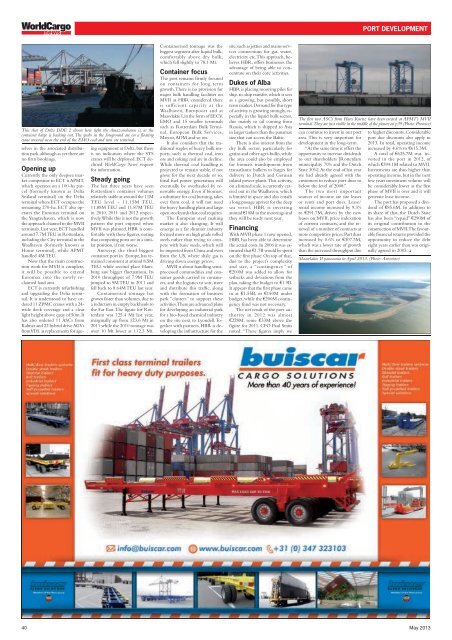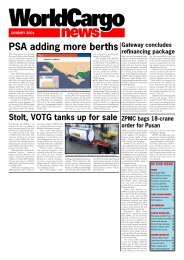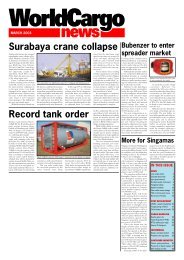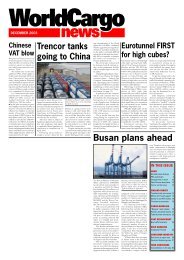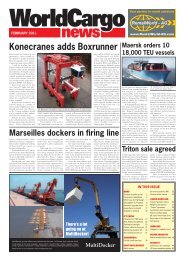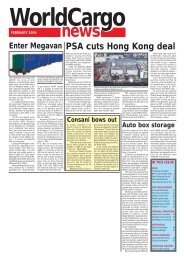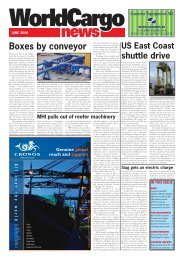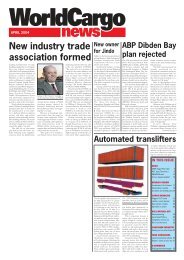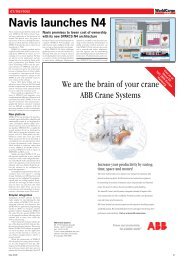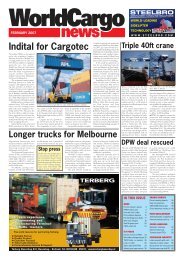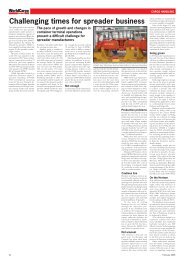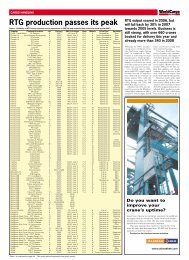Tanjung Priok super port - WorldCargo News Online
Tanjung Priok super port - WorldCargo News Online
Tanjung Priok super port - WorldCargo News Online
Create successful ePaper yourself
Turn your PDF publications into a flip-book with our unique Google optimized e-Paper software.
<strong>WorldCargo</strong><br />
news<br />
PORT DEVELOPMENT<br />
This shot of Delta DDE 2 shows how tight the Amazonehaven is, as the<br />
container barge is backing out. The grabs in the foreground are on a floating<br />
crane moored near the end of the EMO coal and iron ore terminal<br />
selves in the associated distribution<br />
park, although as yet there are<br />
no firm bookings.<br />
Opening up<br />
Currently the only deepsea market<br />
competitor to ECT is APMT,<br />
which operates on a 100-ha parcel<br />
(formerly known as Delta<br />
Sealand terminal) on the Delta<br />
terminal where ECT occupies the<br />
remaining 270-ha. ECT also operates<br />
the Euromax terminal on<br />
the Yangtzehaven, which is now<br />
the approach channel to the MVII<br />
terminals. Last year, ECT handled<br />
around 7.7M TEU in Rotterdam,<br />
including the City terminal in the<br />
Waalhaven (formerly known as<br />
Home terminal), while APMT<br />
handled 4M TEU.<br />
Now that the main construction<br />
work for MVII is complete,<br />
it will be possible to extend<br />
Euromax into the newly reclaimed<br />
land area.<br />
ECT is currently refurbishing<br />
and upgrading the Delta terminal.<br />
It is understood to have ordered<br />
11 ZPMC cranes with a 24-<br />
wide deck coverage and a clear<br />
light height above quay of 50m. It<br />
has also ordered 11 ASCs from<br />
Kalmar and 22 hybrid drive AGVs<br />
from VDL as replacements for ageing<br />
equipment at Delta, but there<br />
is no indication where the STS<br />
cranes will be deployed. ECT declined<br />
<strong>WorldCargo</strong> <strong>News</strong>’ request<br />
for information.<br />
Steady going<br />
The last three years have seen<br />
Rotterdam’s container volumes<br />
relatively stable at around the 11M<br />
TEU level - 11.15M TEU,<br />
11.88M TEU and 11.87M TEU<br />
in 2010, 2011 and 2012 respectively.<br />
While this is not the growth<br />
pattern the <strong>port</strong> enjoyed when<br />
MVII was planned, HBR is comfortable<br />
with these figures, noting<br />
that competing <strong>port</strong>s are in a similar<br />
position, if not worse.<br />
Antwerp, the third biggest<br />
container <strong>port</strong> in Europe, has remained<br />
consistent at around 8.5M<br />
TEU, while second place Hamburg<br />
saw bigger fluctuations. Its<br />
2010 throughput of 7.9M TEU<br />
jumped to 9M TEU in 2011 and<br />
fell back to 8.64M TEU last year.<br />
Containerised tonnage has<br />
grown faster than volumes, due to<br />
a reduction in empty backhauls to<br />
the Far East. The figure for Rotterdam<br />
was 125.4 Mt last year,<br />
marginally up from 123.6 Mt in<br />
2011 while the 2010 tonnage was<br />
over 10 Mt lower at 112.3 Mt.<br />
Containerised tonnage was the<br />
biggest segment after liquid bulk,<br />
comfortably above dry bulk,<br />
which fell slightly to 78.1 Mt.<br />
Container focus<br />
The <strong>port</strong> remains firmly focused<br />
on containers for long term<br />
growth. There is no provision for<br />
major bulk handling facilities on<br />
MVII as HBR considered there<br />
is sufficient capacity at the<br />
Waalhaven, Europoort and at<br />
Maasvlakte I, in the form of EECV,<br />
EMO and 15 smaller terminals<br />
such as Rotterdam Bulk Terminal,<br />
European Bulk Services,<br />
Marcor, ADM and so on.<br />
It also considers that the traditional<br />
staples of heavy bulk im<strong>port</strong>s,<br />
such as thermal coal, iron<br />
ore and coking coal are in decline.<br />
While thermal coal handling is<br />
projected to remain stable, if not<br />
grow, for the next decade or so,<br />
fossil fuel power generation will<br />
eventually be overhauled by renewable<br />
energy. Even if biomass,<br />
a substitute for coal burning, takes<br />
over from coal, it will not need<br />
the heavy handling plant and large<br />
open stockyards that coal requires.<br />
The European steel making<br />
market is also changing. It will<br />
emerge as a far slimmer industry<br />
focused more on high grade rolled<br />
steels rather than trying to compete<br />
with basic steels, which will<br />
be im<strong>port</strong>ed from China and even<br />
from the US, where shale gas is<br />
driving down energy prices.<br />
MVII is about handling semiprocessed<br />
commodities and consumer<br />
goods carried in containers,<br />
and the logistics to sort, store<br />
and distribute this traffic, along<br />
with the formation of business<br />
park “clusters” to sup<strong>port</strong> these<br />
activities. There are advanced plans<br />
for developing an industrial park<br />
for a bio-based chemical industry<br />
on the site next to Lyondell. Together<br />
with partners, HBR is developing<br />
the infrastructure for the<br />
site, such as jetties and mains services<br />
connections for gas, water,<br />
electricity etc. This approach, believes<br />
HBR, offers businesses the<br />
advantage of being able to concentrate<br />
on their core activities.<br />
Dukes of Alba<br />
HBR is placing mooring piles for<br />
ship-to-ship transfer, which it sees<br />
as a growing, but possibly, short<br />
term market. Demand for this type<br />
of activity is growing strongly, especially<br />
in the liquid bulk sector,<br />
due mainly to oil coming from<br />
Russia, which is shipped to Asia<br />
in larger tankers than the panamax<br />
size that can access the Baltic.<br />
There is also interest from the<br />
dry bulk sector, particularly for<br />
grains and other agri-bulks, while<br />
the area could also be employed<br />
for biomass transhipment from<br />
transatlantic bulkers to barges for<br />
delivery to Dutch and German<br />
inland power plants. This activity,<br />
on a limited scale, is currently carried<br />
out in the Waalhaven, which<br />
is limited in space and also entails<br />
a long passage upriver for the deep<br />
sea vessel. HBR is investing<br />
around €10M in the moorings and<br />
they will be ready next year.<br />
Financing<br />
With MVII phase 1 now opened,<br />
HBR has been able to determine<br />
the actual costs. In 2006 it was estimated<br />
that €1.7B would be spent<br />
on the first phase. On top of that,<br />
due to the project’s complexity<br />
and size, a “contingency” of<br />
€200M was added to allow for<br />
setbacks and deviations from the<br />
plan, taking the budget to €1.9B.<br />
It appears that the first phase came<br />
in at €1.55B, or €150M under<br />
budget, while the €200M contingency<br />
fund was not necessary.<br />
The net result of the <strong>port</strong> authority<br />
in 2012 was almost<br />
€228M, some €33M above the<br />
figure for 2011. CFO Paul Smits<br />
noted: “These figures imply we<br />
The first two ASCs from Hans Kuenz have been erected at APMT’s MVII<br />
terminal. They are just visible in the middle of the picture on p39 (Photo: Provoice)<br />
can continue to invest in our <strong>port</strong><br />
area. This is very im<strong>port</strong>ant for<br />
development in the long-term.<br />
“At the same time it offers the<br />
op<strong>port</strong>unity to increase dividends<br />
to our shareholders [Rotterdam<br />
municipality 70% and the Dutch<br />
State 30%]. At the end of last year<br />
we had already agreed with the<br />
customers to reduce <strong>port</strong> dues to<br />
below the level of 2008.”<br />
The two most im<strong>port</strong>ant<br />
sources of income are site leases<br />
or rents and <strong>port</strong> dues. Lease/<br />
rental income increased by 9.3%<br />
to €291.7M, driven by the new<br />
leases on MVII, price indexation<br />
of current contracts, and the renewal<br />
of a number of contracts at<br />
more competitive prices. Port dues<br />
increased by 0.6% to €307.3M,<br />
which was a lower rate of growth<br />
than the increased throughput due<br />
to higher discounts. Considerable<br />
<strong>port</strong> due discounts also apply in<br />
2013. In total, operating income<br />
increased by 4.6% to €615.3M.<br />
A total of €625.7M was invested<br />
in the <strong>port</strong> in 2012, of<br />
which €394.1M related to MVII.<br />
Investments are thus higher than<br />
operating income, but in the next<br />
few years investment volume will<br />
be considerably lower as the first<br />
phase of MVII is over and it will<br />
generate lease income..<br />
The <strong>port</strong> has proposed a dividend<br />
of €85.6M. In addition to<br />
its share of that, the Dutch State<br />
has also been “repaid” €290M of<br />
its original contribution to the<br />
construction of MVII. The favourable<br />
financial returns provided the<br />
op<strong>port</strong>unity to reduce the debt<br />
eight years earlier than was originally<br />
agreed in 2005. ❏<br />
Maasvlakte II panorama in April 2013. (Photo: Aeroview)<br />
40<br />
May 2013


